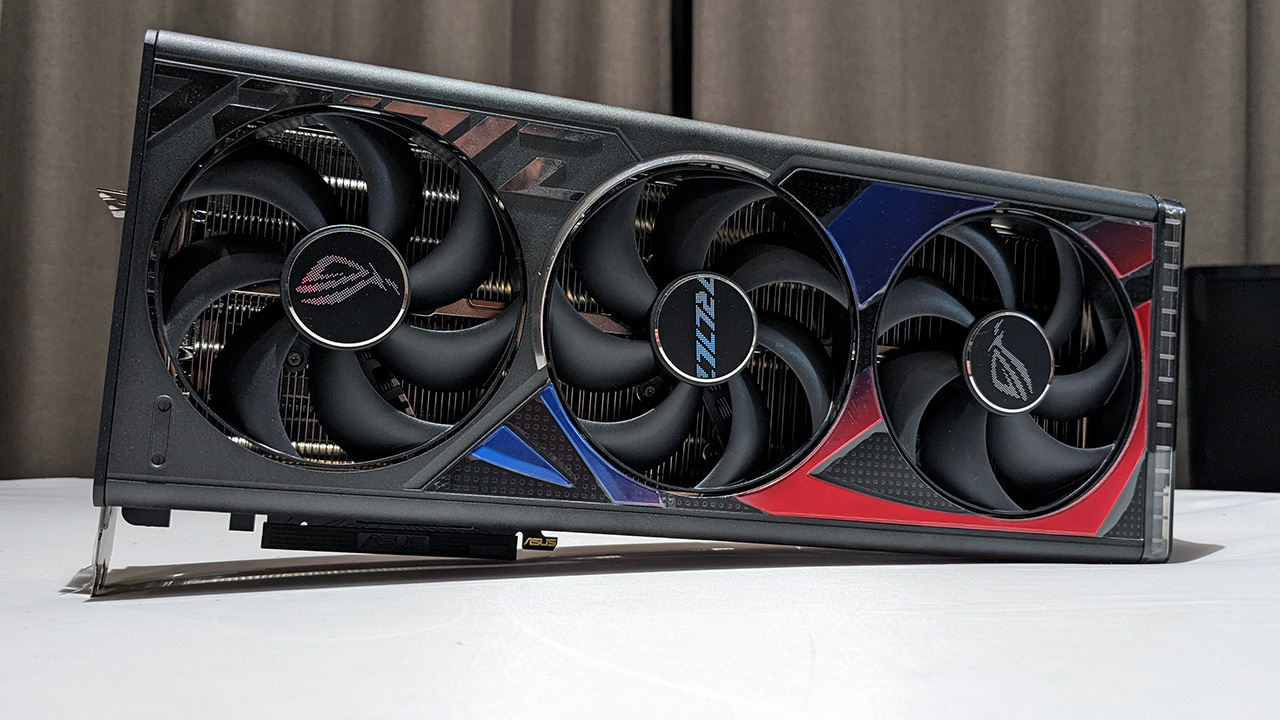Our Verdict
The Asus ROG Strix RTX 4090 improves over the FE in every way with typical ROG flourishes. It's a pixel pushing monster, but you'll be required to pay a hefty premium, and that will be step too far for many.
For
- Mega 4K gaming performance
- Exceptionally cool and quiet
- Five video outputs
- Decent OC headroom
Against
- Unattainable for most
- Big price premium over cheaper RTX 4090s
- Huge size
PC Gamer's got your back
If you're a gamer and want the best, there's only one choice, and it's the one graphics card that sits above all, the RTX 4090. For a primer and architecture overview, check out our review of the RTX 4090 Founders Edition. It's big, it's expensive and it's unapologetically powerful, and that's just the Founders Edition!
Asus has expectedly given the mighty AD102 GPU the ROG treatment. The RTX 4090 Founders Edition isn't what you'd call a compact card, but Asus has taken it to the next level. Asus ROG Strix GeForce RTX 4090 OC Edition (say that ten times fast) is a huge card at 357.6 x 149.3 x 70.1mm and it will be a challenge to house in many cases. It's heavy too, so if you’re into weightlifting and PC gaming, the Asus is here to help. It takes up 3.5 slots, which means four in reality.
The card features a futuristic look with lots of RGB and a few appealing little touches we've come to expect from high end Asus ROG products. It comes with a factory overclock, too, with an official rated boost clock of 2,610MHz. That's an increase of 90MHz over the FE. You can also set it to an even higher overclocked starting point at 2,640MHz via Asus' GPU Tweak software. The memory clock remains unchanged at 21Gbps regardless.
The Asus comes with an eye watering price. It's a whopping $1,999 / £2,169 / AU$3,799 so you'll be asked to pay a big premium over entry level RTX 4090s. Not that 'entry level' and 'RTX 4090' belong in the same sentence. Really, that's too much money, but flagship products attract a premium, and if you're an enthusiast and can afford it, then no one should judge you. Nvidia and Asus certainly won't.
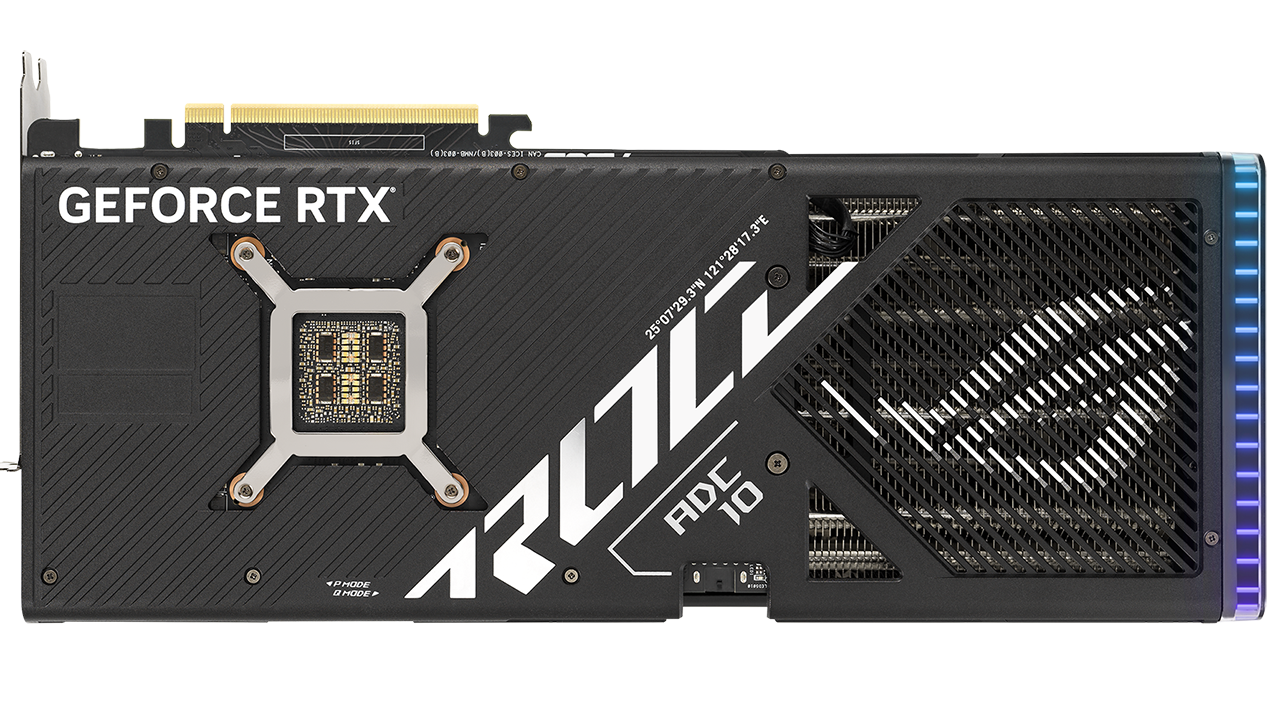
GPU: Nvidia AD102-300-A1
Shader Units: 16,384
Boost clock speed: 2,610MHz (Default), 2,640MHz (OC Mode)
Memory capacity: 24GB GDDR6X
Memory speed: 21Gbps
Outputs: 3x DisplayPort 1.4a, 2x HDMI 2.1a
Power connectors: 1x 16-pin
Price: $1,999| £2,169 | AU$3,799
Asus has gone all out with the RTX 4090 Strix. It takes up 3.5 slots, which as I've already said actually means four. There's RGB-lit ROG branding along the side, and more RGB around the end of the card. The design could be considered polarizing, though I like it personally. There's a full length backplate, as you'd expect at this level.
The card includes the new 16-pin 12VHPWR connector. Asus includes a 4x 8-pin adapter for use with older power supplies. If you add that to the 75W from the PCIe slot, the card has up to 675W on tap. Like other 4090s, make sure the connector is 100% inserted with as little bending as possible to avoid any potential melting issue, which frankly to me seems like it's been overblown.
An enormous card means an enormous cooler. It includes a vapor chamber, seven heatpipes and a huge number of fins with excellent heat dissipation capability. The underneath of the heatsink is dotted with an array of thermal strips to keep the memory chips and VRM cool.
Load temperatures maxed out at just over 60°C, that’s simply stunning for a 450W card, though at the same time, not entirely unexpected with this kind of cooling capability. In the confines of a case, temperatures will surely be a few degrees higher, but even still, they'll be low. The Asus' power consumption numbers were hardly higher than those of the Founders Edition.


Asus usually includes some extras over and above a typical FE card. In addition to the monster cooler and higher clocks, you get dual BIOS, with a switch to choose between default and low noise settings. A quick test revealed zero difference between the two. There are a pair of 4-pin fan headers too, which is very useful for adjusting external fan speeds according to the GPU temperature.
If dropping $1599 USD or more on a graphics card is acceptable to you, what's a few hundred extra between friends?
The PCB is simply extreme. The Asus' 24-phase design with 70a stages looks like it was built with the much higher TDPs in mind. Should an RTX 4090 Ti eventuate in the future, or you wish to overclock your card with appropriate cooling, the Asus won't break a sweat. The PCB is still quite compact in terms of length. This allows Asus to follow the recent trend of blowing air through part of the card and out into the path of front-to-back case airflow.
The video output complement is excellent. Though it misses out on DP 2.1 – a significant weakness of all RTX 4090's - you do get dual HDMI 2.1a and three DisplayPort 1.4a. You can use up to four ports at the same time.



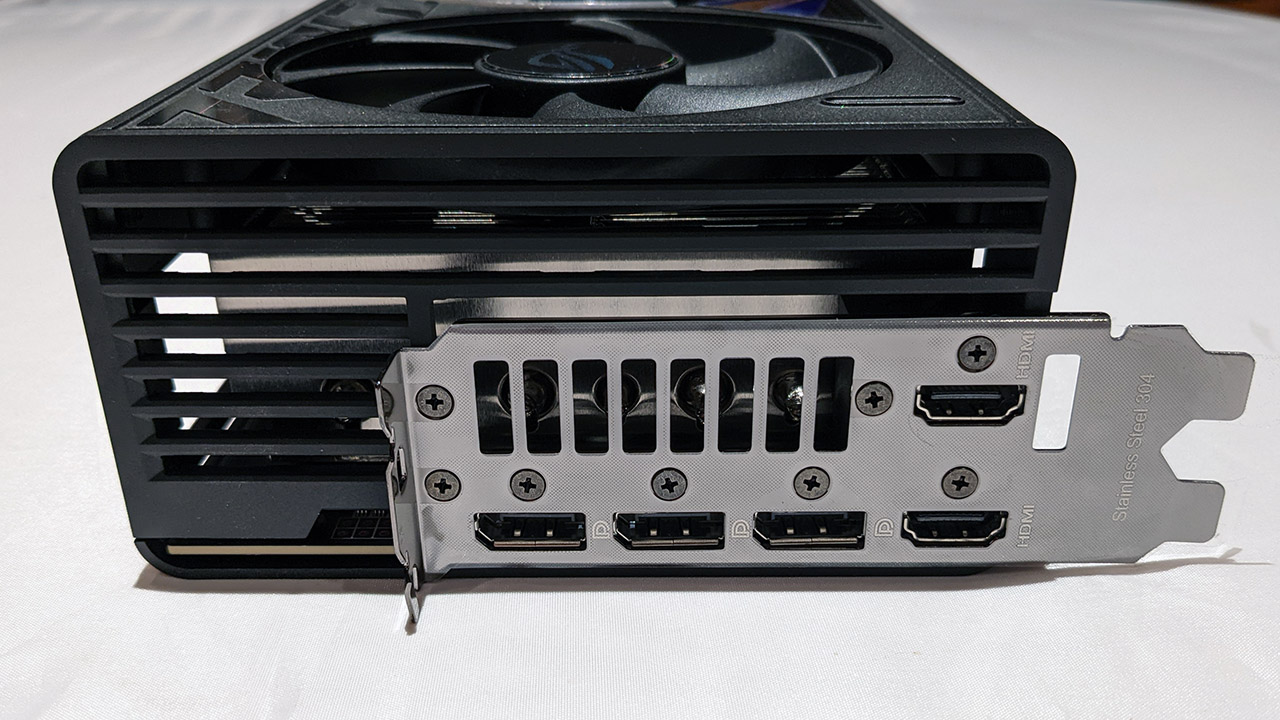


So how does it perform? Pretty bloody well as you can see in the following graphs.
A note on my methodology. Where applicable, I've run benchmarks with most of the ray tracing settings enabled. This makes the Radeon RX 6000 cards look quite poor in many instances; however, these numbers will be more relevant to RX 7900 series cards, and all graphics cards going forward.
Synthetic gaming performance



1440p Gaming Performance


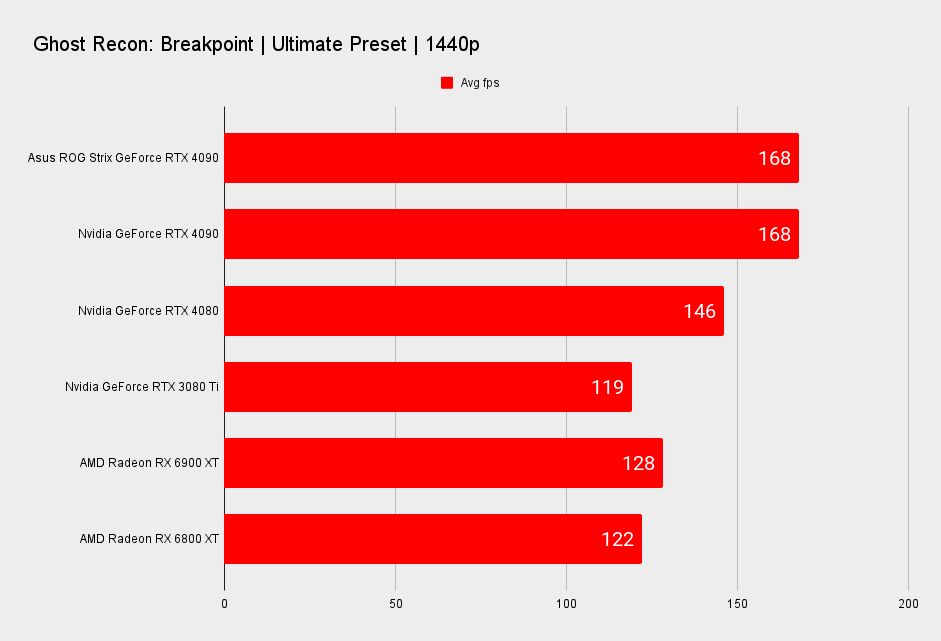

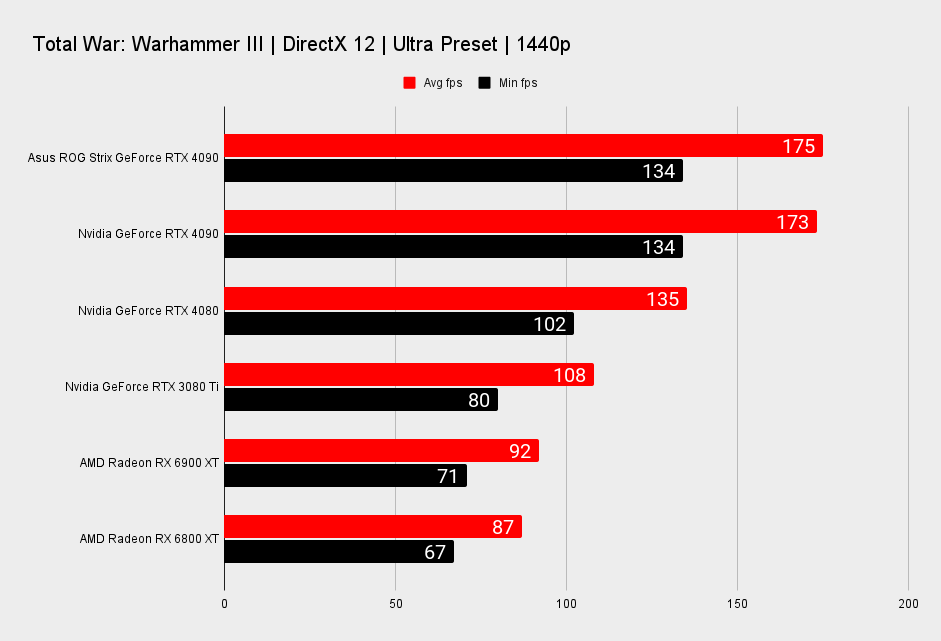
4K Gaming Performance



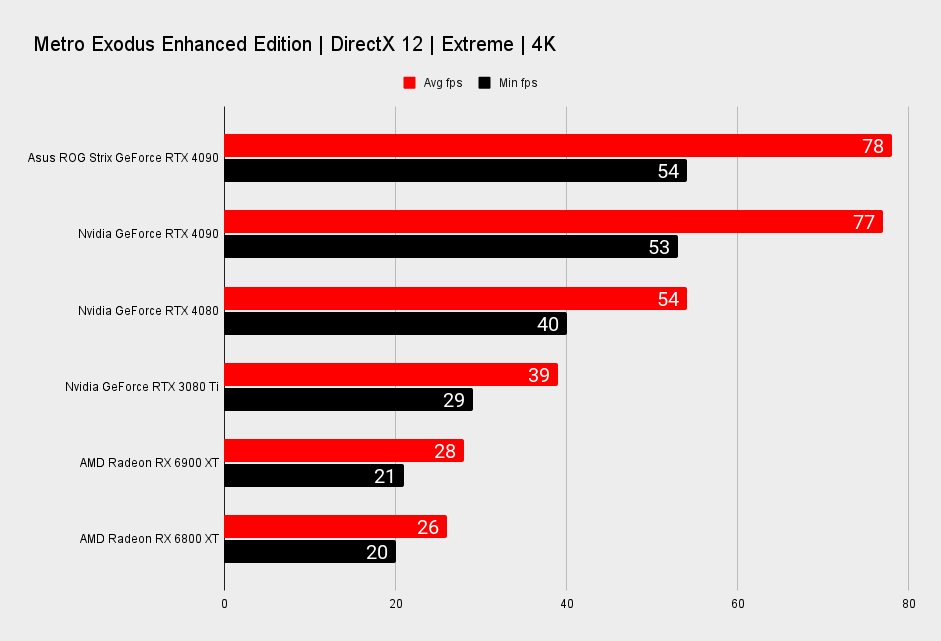

CPU: Intel Core i9 12900K
Motherboard: Asus ROG Maximus Z690 Apex
RAM: 2x 16GB G.Skill Trident-Z DDR5-6400 C36
Storage: 2TB Seagate FireCuda 530
Cooling: Cooler Master PL360 Flux 360mm AIO
PSU: Corsair AX1000
Surprisingly, the Asus didn't outperform the Founders Edition by as much as I would expect. That's because of the way Nvidia's boost algorithm works. It'll clock higher if the card is kept cool enough and there's enough power budget. During 10 minutes of 3DMark Speedway looping, the average clock of the Asus card was 2,776MHz, easily higher than the rated 2,610MHz boost clock, but the same can be said of the Founders Edition, which achieved 2,745MHz.
Although the performance difference wasn't that great, the Asus Strix was absolutely silent, and could not be heard over the sound of my system's AIO fans.

Just look at that PCB! If you can keep it cool enough, the card should reward you with some decent overclocking headroom. I wasn't quite able to crack the 3GHz barrier but a stable 2,945MHz clock is still remarkable for a GPU compared to just a few years back. Each chip is different though, and you may find that simple tweaks to the power limits or fan curves can significantly affect your overclock. If you buy a card like this, you'll want to tinker with it!
How do you judge a card like this? It's priced at a level well outside what a typical gamer would even consider. But then this isn't a card for your typical gamer, much like a supercharged V8 isn't aimed at a typical commuter.
The Asus RTX 4090 Strix is extreme in every way. It's an excellent option if you’re after a genuine flagship that looks the part, while offering performance, cooling and low noise levels to match it. It's the kind of card that will stay relevant for many years to come.
Top tier ROG products usually come with premium price tags, though if dropping $1,599 or more on a graphics card is acceptable to you, what's a few hundred extra between friends? The Asus is over the top and honestly its overkill and far too expensive for 98% of gamers, but the Asus and other premium RTX 4090s simply have no competition. Given the generational performance uplift on offer, I can't help but love it, even if most will never get closer than seeing it locked behind a glass door in their local PC shop.
The Asus ROG Strix RTX 4090 improves over the FE in every way with typical ROG flourishes. It's a pixel pushing monster, but you'll be required to pay a hefty premium, and that will be step too far for many.

Chris' gaming experiences go back to the mid-nineties when he conned his parents into buying an 'educational PC' that was conveniently overpowered to play Doom and Tie Fighter. He developed a love of extreme overclocking that destroyed his savings despite the cheaper hardware on offer via his job at a PC store. To afford more LN2 he began moonlighting as a reviewer for VR-Zone before jumping the fence to work for MSI Australia. Since then, he's gone back to journalism, enthusiastically reviewing the latest and greatest components for PC & Tech Authority, PC Powerplay and currently Australian Personal Computer magazine and PC Gamer. Chris still puts far too many hours into Borderlands 3, always striving to become a more efficient killer.
